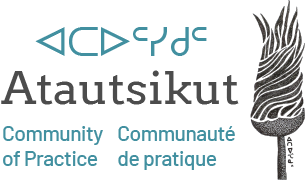Dans cette présentation, nous abordons le thème de l’attachement. Nous en explorons les phases et les types, tel que conçus dans la pensée occidentale. Ce concept est aussi revu en considérant que dans plusieurs sociétés, dont autochtones, l’éducation des enfants repose sur des liens privilégiés avec plusieurs figures significatives; il est donc important de penser la théorie de l’attachement en dehors de son cadre traditionnelNous abordons des éléments de la culture inuk afin de repenser l’attachement dans son contexte, l’impact de l’histoire et de l’environnement sur l’attachement ainsi que des stratégies concrètes pour intervenir auprès des jeunes et des familles.

Ressources des rencontres Atautsikut
Références utilisées
- Adams, C. (2018). Nurturing Belonging:(Re) centering Indigenous Perspectives on Disability. Child and Youth Care: Disability Matters, 12
- Carriere, J., & Richardson, C. (2009). From longing to belonging: Attachment theory, connectedness, and indigenous children in Canada. Passion for action in child and family services: Voices from the prairies, 49-67.
- Kim-Meneen, J. (2018). Understanding Parenting Styles of Second-Generation Parents of Residential School Survivors Within Treaty 8 Reserves.
- Kirmayer, L. J., Fletcher, C., & Watt, R. (2009). Locating the ecocentric self: Inuit concepts of mental health and illness. Healing traditions: the mental health of Aboriginal peoples in Canada. UBC Press, Vancouver, British Columbia, Canada, 289-314.
- Lafrance, J. & Collins, D. (2003). Residential schools and Aboriginal parenting: Voices of parents. Native Social Work Journal, 4(1), 104-125
- Pauktuutit Inuit Women of Canada. (2006). The Inuit way: A guide to Inuit culture. Pauktuutit Inuit Women of Canada.
- Root, D. (2018). Indigenous Families: Fostering Attachment Our Way (Doctoral dissertation, Mount Saint Vincent University).
- Caregiver-Infant Attachment for Aboriginal Families (ccnsa-nccah.ca)
- Ainsworth MDS, Blehar M, Waters E, Wall S. Patterns of attachment: A Psychological study of the strange situation. Hillsdale, NJ: Lawrence Erlbaum Associates; 1978.
- Benzies, K. M. (2016). Parenting in Canadian Aboriginal cultures. H. Selin (Ed.), Parenting across cultures: Childrearing, motherhood and fatherhood in non-western cultures. The history of non-western science (pp. 379-392). Dordrecht, NL: Springer.
- Bowlby J. Attachment. 2nded. New York, NY: Basic Books; 1982. Attachment and loss; vol 1.
- Cassidy, J., & Shaver, P. R. (1999). Handbook of attachment: Theory, research, and clinical applications. New York, NY: Guilford Press.
- Choate, P. W., Kohler, T., Cloete, F., CrazyBull, B., Lindstrom, D., & Tatoulis, P. (2019). Rethinking Racine v Woods from a Decolonizing Perspective: Challenging the Applicability of Attachment Theory to Indigenous Families Involved with Child Protection. Canadian Journal of Law & Society/La Revue Canadienne Droit et Société, 34(1), 55-78.
- Erickson MF, Sroufe LA, Egeland B. The relationship between quality of attachment and behavior problems in preschool in a high-risk sample. Monographs of the Society for Research in Child Development1985;50(1-2):147-166
- Hossain, B., & Lamb, L. (2019). Cultural Attachment and Wellbeing Among Canada’s Indigenous People: A Rural Urban Divide. Journal of Happiness Studies, 1-22.
- Swanson Cain, C. (2006). Attachment disorders : treatment strategies for traumatized children. Oxford: Rowman & Littlefield Publishers.
- Van Ijzendoorn, M. H., & Kroonenberg, P. M. (1988). Cross-cultural patterns of attachment: A meta-analysis of the strange situation. Child development, 147-156.
Pour aller plus loin

Inunnguiniq : l’art inuit d’élever les enfants | Centre de collaboration nationale de la santé autochtone (CCNSA).
Dans cet article, le Centre de collaboration nationale de la santé autochtone (CCNSA) offre une fenêtre sur les conceptions et termes inuit qui sont au cœur de l’approche holistique du développement de l’enfant.
Image: CCNSA
Aussi disponible en inuktitut (Nunavut) et en anglais

Structure familiale | Atlas des peuples autochtones du Canada
Cette page de l’Atlas des peuples autochtones du Canada examine quelques distinctions culturelles quant à la structure familiale, notamment la naissance, l’allaitement et l’adoption chez les Inuit.
Image: Archives Inuit Tapiriit Kanatami; Atlas des peuples autochtones du Canada
Disponible en français et en anglais





